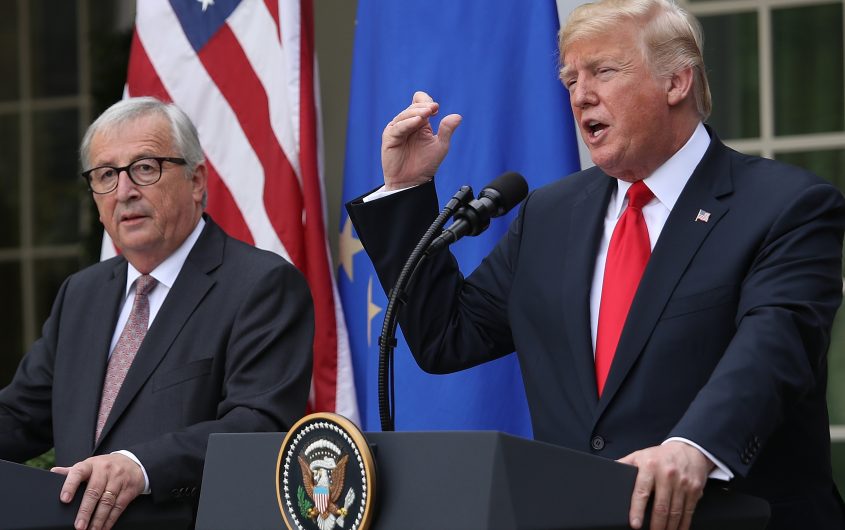
Win McNamee/Getty Images
For Now, the White House Sees Trade with the EU as Win-Win

Peter S. Rashish
Vice President; Director, Geoeconomics Program
Peter S. Rashish, who counts over 30 years of experience counseling corporations, think tanks, foundations, and international organizations on transatlantic trade and economic strategy, is Vice President and Director of the Geoeconomics Program at AICGS. He also writes The Wider Atlantic blog.
Mr. Rashish has served as Vice President for Europe and Eurasia at the U.S. Chamber of Commerce, where he spearheaded the Chamber’s advocacy ahead of the launch of the Transatlantic Trade and Investment Partnership. Previously, Mr. Rashish was a Senior Advisor for Europe at McLarty Associates, Executive Vice President of the European Institute, and a staff member and consultant at the International Energy Agency, the World Bank, UN Trade and Development, the Atlantic Council, the Bertelsmann Foundation, and the German Marshall Fund.
Mr. Rashish has testified before the House Financial Services Subcommittee on International Monetary Policy and Trade and the House Foreign Affairs Subcommittee on Europe and Eurasia and has advised three U.S. presidential campaigns. He has been a featured speaker at the Munich Security Conference, the Aspen Ideas Festival, and the European Forum Alpbach and is a member of the Board of Directors of the Jean Monnet Institute in Paris and a Senior Advisor to the European Policy Centre in Brussels. His commentaries have been published in The New York Times, the Financial Times, The Wall Street Journal, Foreign Policy, and The National Interest, and he has appeared on PBS, CNBC, CNN, NPR, and the BBC.
He earned a BA from Harvard College and an MPhil in international relations from Oxford University. He speaks French, German, Italian, and Spanish.
The transatlantic trade truce announced by President Trump and EU Commission President Juncker after their meeting in the White House yesterday is significant for two reasons.
First, the U.S. president gave his seal of approval to the idea of “strong trade relations in which both of us will win” in the joint U.S.-EU statement issued by the two leaders. For Trump, who only a day before his get-together with Juncker bemoaned the fact that the United States “lost $817 Billion on Trade last year” (referring to the U.S. trade deficit in goods), this was a considerable change of course.
Some caution is still in order. Rhetorical support for positive-sum trading relations is important, but the fact that one outcome of the meeting was increased EU purchases of U.S. soybeans and natural gas suggests the administration has not given up its ambition to reduce the U.S. trade deficit with the EU. Much will depend on how the “Executive Working Group” set up yesterday to move forward a common trade agenda will measure progress. If bringing down the U.S. trade deficit with the EU—something trade-policy tools cannot be expected to do—is part of that calculation, the U.S. is destined for disappointment. In which case the president could well decide to pull out of the talks and impose new tariffs, for example on automobiles.
More optimism may be in order when it comes to the second important aspect of the Trump-Juncker meeting: cooperation on China. While some of the president’s aides have spoken positively about the value of working with the EU to confront the challenge from China, yesterday’s gathering marked the first time the president himself endorsed this idea. When Trump and Juncker agreed in their declaration to “work closely together with like-minded partners to reform the WTO and to address unfair trading practices, including intellectual property theft, forced technology transfer, industrial subsidies, distortions created by state owned enterprises, and overcapacity,” they clearly had China in mind.
This commitment to working with the EU on unfair trading practices does not mean the U.S. is going to give up trying to use tariffs to force changes by Beijing. Still, Trump’s support for a second track of economic diplomacy with the EU and within the WTO to counter China’s state-capitalist model marks a change. Perhaps the administration is now united around the notion that the U.S. cannot advance its key global economic interests alone and needs cooperation with like-minded trading partners. And that instead of engineering a de facto withdrawal from the WTO, the White House sees the opportunities for the U.S. in working with the grain of the institutions of the liberal economic order.
The friendly atmospherics of yesterday’s White House meeting notwithstanding, the U.S. and the EU are far from the intense cooperation that characterized the Transatlantic Trade and Investment Partnership (TTIP) negotiations under the Obama administration or even the more modest engagement of the Transatlantic Economic Council launched during the previous Bush administration.
As long as the U.S. maintains its tariffs on EU steel and aluminum (purportedly for national security reasons) and the EU keeps its retaliatory tariffs in place, a skirmish or two across the Atlantic cannot be ruled out. But a trade war has been avoided.








